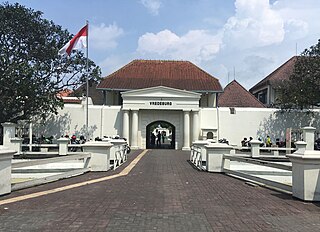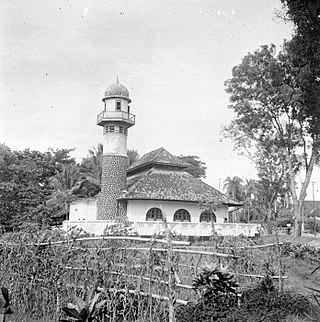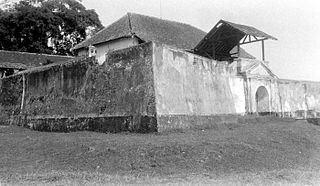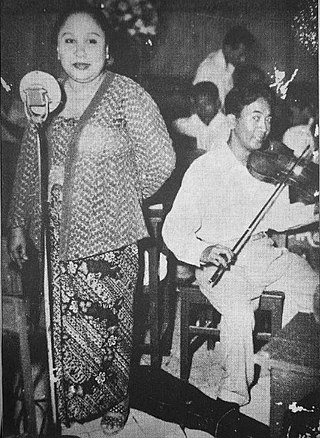
Prince Diponegoro, also known as Dipanegara, was a Javanese prince who opposed the Dutch colonial rule. The eldest son of the Yogyakartan Sultan Hamengkubuwono III, he played an important role in the Java War between 1825 and 1830. After his defeat and capture, he was exiled to Makassar, where he died, 69 years old.

The Sultanate of Mataram was the last major independent Javanese kingdom on the island of Java before it was colonised by the Dutch. It was the dominant political force radiating from the interior of Central Java from the late 16th century until the beginning of the 18th century.

Fort Vredeburg Museum was a former colonial fortress located in the city of Yogyakarta, Special Region of Yogyakarta, Indonesia. The military complex has been converted into a museum of the Indonesian independence struggle which was opened in 1992. It is located in front of Gedung Agung and near the Kraton Yogyakarta.

There are 1,340 recognised ethnic groups in Indonesia. The vast majority of those belong to the Austronesian peoples, with a sizeable minority being Melanesians. Indonesia has the world's largest number of Austronesians and Melanesians.

Satu Suro is the first day of the Javanese calendar year in the month of Suro, corresponding with the first Islamic month of Muharram. It is mainly celebrated in Java, Indonesia, and by Javanese people living elsewhere.

Gorontalo people, also known as Gorontalese are a native ethnic group and the most populous ethnicity in the northern part of Sulawesi. The Gorontalo people have traditionally been concentrated in the provinces of Gorontalo, North Sulawesi, and the northern part of Central Sulawesi.

Suharso, (1912–1971) also spelled Soeharso, was an Indonesian medical doctor known for his work with disabled people and in the rehabilitation of people injured during the Indonesian National Revolution. He was declared to be a National Hero of Indonesia in 1973.

Masjid Jami' Al-Makmur Cikini is located on Jalan Raden Saleh Raya in Cikini, Central Jakarta, and is one of the oldest mosques in the locality. It was formerly known as Tjikini Mosque.

The Great Mosque of Surakarta is an 18th-century Javanese mosque in Surakarta, Central Java, Indonesia. It is the royal mosque of the Surakarta Sunanate.

Fort Willem II of Ungaran is a late 18th-century fort built by the Dutch in Ungaran, Semarang Regency, Central Java, Indonesia. Its main purpose was to control an important trade route between Semarang and Yogyakarta. The fort is the place where Prince Diponegoro was imprisoned while waiting for his judgment in Batavia and further exile to Makassar. The fort is currently used as a dormitory for the families of Indonesian police personnel.

Fort Willem I, known in Indonesian/Javanese as Benteng Pendem Ambarawa, is a 19th-century Dutch fortress in Ambarawa, Central Java, Indonesia.

Al-Wustho Mangkunegaran Mosque is a historic mosque located in the Central Javanese city of Surakarta, to the west of the Mangkunegaran Palace. The mosque is one of the three oldest mosques of Surakarta. Al-Wustho Mangkunegaran Mosque was inaugurated as a state mosque of the Mangkunegaran Palace.

Raden Soediro was an Indonesian politician who served as the first Governor of Jakarta, between 1958 and 1960. Prior to becoming Governor, Soediro served as Jakarta's mayor for five years until the city was made its own special capital region. Soediro was also Governor of Sulawesi between 1951 and 1953.

Bedil tombak or bedil tumbak is a type of early firearm from the Indonesian archipelago. The weapon consists of a gun or small cannon mounted on a wooden pole, forming a type of weapon known as "pole gun".

Cimahi Station (CMI) is a class II railway station located in Baros, Padalarang, West Bandung Regency, to be precise on Station Street, Bandung Barat. The station, which is located at an altitude of +723 meters, is included in the Operational Area II Bandung.

Purwosari Station (PWS) is a large class type C railway station located in Purwosari, Laweyan, Surakarta, Central Java, Indonesia. The station which is located at an altitude of +98 m is included in the Operational Area VI Yogyakarta and only serves economy class trains across south and local or commuter.

Raden Ajeng Srimulat, also known simply as Srimulat, was an Indonesian comedian, actor, singer, and founding member of the popular Srimulat comedy troupe. She was the wife of Teguh Slamet Rahardjo, one of the most famous Indonesian comedians of the postwar era.
Teguh Slamet Rajardjo (1926–1996), popularly known as Teguh Srimulat, was an Indonesian comedian and actor. With his first wife Raden Ajeng Srimulat, he founded the Srimulat comedy troupe which became popular in the postwar era for its absurdist Slapstick comedy and social satire.
Abdul Rasjid Siregar gelar Mangaradja Mahkota Soeangkoepon, commonly known as Dr. Abdul Rasjid, was a politician and physician in the Dutch East Indies. He was elected or appointed to the Volksraad from 1931 to 1942, during which time he sat with the Indonesian nationalist faction. During the 1930s, he became convinced that public health and cooperation with traditional healers should be central to the mission of physicians in the Indies.


















